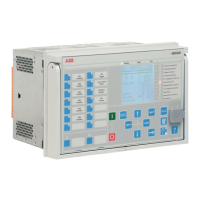the application nominal current matches the sensor’s capability which is up
to 4000 A.
The setting
Rated secondary value
is calculated by using
Equation 1
.
(Equation 3)
From
Table 47
it is seen that with the 1250 A application nominal current
value, the maximum setting for overcurrent protection is 40 xIn. This covers
the customer specification requirements for overcurrent settings of up to
20 xIn.
Voltage sensor setting example
The voltage sensor is based on the resistive divider or capacitive divider
principle. Therefore, the voltage is linear throughout the whole measuring
range. The output signal is a voltage, directly proportional to the primary
voltage. For the voltage sensor, all parameters are readable directly from its
rating plate and/or sensor routine test protocol, and conversions are not
needed.
Figure 34: Example of ABB voltage sensor KEVA 17.5 B21 rating plate
In this example the system phase-to-phase voltage rating is 10 kV. Thus, the
Primary voltage
parameter is set to 10 kV. For protection relays with sensor
measurement support, the
Voltage input type
is set to "Voltage sensor". The
VT connection parameter is set to the "WYE" type. The division ratio for ABB
voltage sensors is most often 10000:1. Thus, the
Division ratio
parameter is
usually set to "10000". The primary voltage is proportionally divided by this
division ratio.
Table 48: Example setting values for voltage sensor
Setting
Value
Primary voltage 10 kV
VT connection Wye
Table continues on the next page
1MRS757644 H Basic functions
620 series
Technical Manual
111

